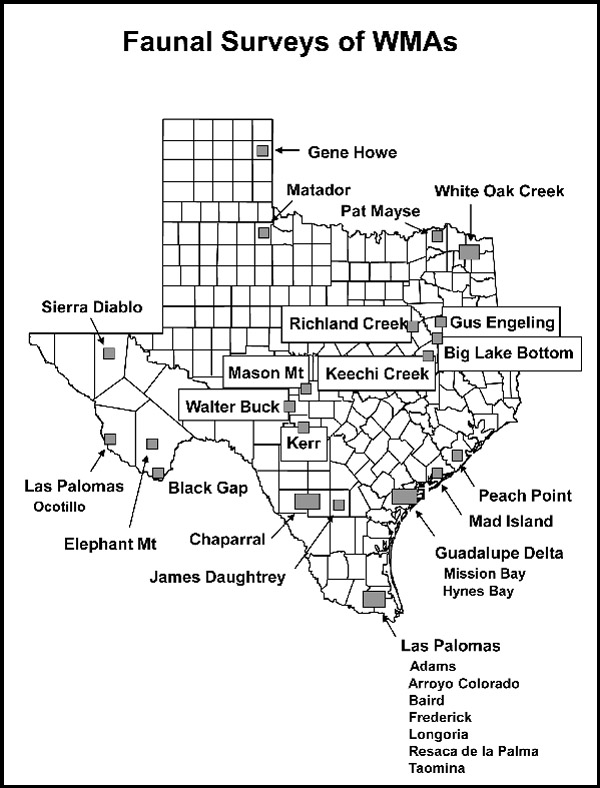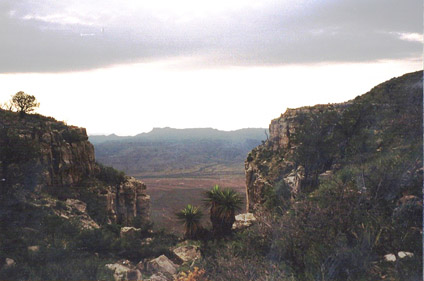 Mammal Surveys of TPWD Wildlife Management Areas
Mammal Surveys of TPWD Wildlife Management Areas
Collaborators: Robert D. Bradley, Robert J. Baker, Clyde Jones, Nick Parker, and David J. Schmidly - Texas Tech University; Andrew Sansom, Robert L. Cook, Ronnie R. George, and David H. Riskind - Texas Parks and Wildlife Department.
 From 1996 through 1999, researchers at Texas Tech University collaborated with Texas
Parks and Wildlife Department in conducting faunal surveys on state-owned properties.
The objectives of these endeavors were to: assist TPWD with its ongoing base-line
inventories; archive voucher specimens (skins and skeletal material) for historical
documentation of existing biodiversity and for future reference; archive tissue samples
for future studies pertaining to systematics, genetics, ecotoxicology, and emerging
viruses (e.g. rabies, hantavirus, and arenavirus); provide GIS localities of traplines
for use in habitat preference studies or future base-line studies; and provide data
and information to the TPWD and the scientific community.
From 1996 through 1999, researchers at Texas Tech University collaborated with Texas
Parks and Wildlife Department in conducting faunal surveys on state-owned properties.
The objectives of these endeavors were to: assist TPWD with its ongoing base-line
inventories; archive voucher specimens (skins and skeletal material) for historical
documentation of existing biodiversity and for future reference; archive tissue samples
for future studies pertaining to systematics, genetics, ecotoxicology, and emerging
viruses (e.g. rabies, hantavirus, and arenavirus); provide GIS localities of traplines
for use in habitat preference studies or future base-line studies; and provide data
and information to the TPWD and the scientific community.
During the course of the project, we conducted surveys on 25 state-owned properties, with a majority of our efforts being focused on Wildlife Management Areas. These surveys generally focused on small mammal species with a particular emphasis on rodents and bats. We recorded more than 45,000 trap-nights for rodents, conducted many mist-net surveys for bats, and used spotlight surveys for carnivores. We collected 2,971 specimens (prepared as standard skin and skulls), obtained tissue samples (blood, heart, liver, kidney, muscle, and spleen) from all specimens, and recorded UTM coordinates for all collecting localities. At least 78 species of mammals were collected, including several underrepresented species (Lasiurus xanthinus, Mormoops megalophylla, Blarina hylophaga, Sylvilagus robustus, Sigmodon ochrognathus, and Microtus pinetorum).
 The results of these surveys ranged from producing the first base-line data for poorly
studied properties, to supplementing and updating existing data for those properties
that had been studied in more detail. We discovered at least 27 county records and
several property-specific records as a result of these inventories.
The results of these surveys ranged from producing the first base-line data for poorly
studied properties, to supplementing and updating existing data for those properties
that had been studied in more detail. We discovered at least 27 county records and
several property-specific records as a result of these inventories.
This collaboration enhanced our knowledge of the biodiversity of state-owned properties, as well as served as an indicator of the biological status of wildlife species across the state of Texas. It has been more than 100 years since the Biological Survey of Texas was conducted by Vernon Bailey and his colleagues. Not only has a significant amount of time passed, but the land use practices and human activities of Texans have changed significantly since that initial survey. Data such as those generated through the interactions of TPWD and Texas Tech University will be instrumental in addressing current and future issues concerning the biodiversity of Texas.
Natural Science Research Laboratory
-
Address
Museum of Texas Tech University, 3301 4th street, Lubbock, TX 79409 -
Phone
806.742.2486 -
Email
nsrl.museum@ttu.edu
